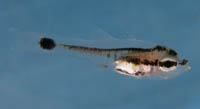 |

For further MBL News and Media Information, contact the MBL Communications Office at (508) 289-7423 or e-mail us at comm@mbl.edu
Back to Resources Page
January 8, 2007
There's No Scent Like Home
New Research Shows Larval Fish Use Smell to Return to Coral Reefs
 |
|
Cardinal fish Ostorinchus doederleini
Photo Credit: Gabriele Gerlach
|
|
MBL, WOODS HOLE, MA—Tiny larval fish living among Australia’s Great Barrier Reef spend the early weeks of their lives swept up in ocean currents that can disperse them far from their places of birth. Given such a life history, one might assume that fish populations would be genetically homogeneous within the dispersal area. Yet the diversity of reef fish species is high and individual reefs contain different fish populations. For such rich biodiversity to have evolved, some form of population isolation is required.
New research from MBL (Marine Biological Laboratory) Associate Scientist Gabriele Gerlach, MBL Adjunct Senior Scientist and Professor of Biology at Boston University Jelle Atema, and their colleagues shows that many fish species can discriminate odors in ocean currents and that some species use home reef scent to return to the reefs where they were born. The olfactory imprinting of natal reefs sheds light on how such a wide diversity of species arose. The homing behavior of reef fishes, the researchers contend, could support population isolation and genetic divergence that may ultimately lead to the formation of new species.
Gerlach, Atema, and their team will present the results of their research in next week’s online Early Edition of The Proceedings of the National Academy of Sciences. The scientists studied fish populations in five neighboring reefs (all part of the Great Barrier Reef) where genetic mixing would be expected. They used a multidisciplinary approach including hydrodynamic modeling to describe prevailing ocean current distribution patterns among the reefs; genetic markers to track the relatedness of three species of fishes which live among the reefs; and olfactory choice tests using flumes to test the larvae’s ability to smell the difference between water from the five reefs.
Their genetic analyses showed that while some fish species do disperse, other species return to their home reef. One species in particular, the cardinal fish (Ostorinchus doederleini), showed significant genetic differences among subpopulations even among reefs separated by as little as 3 km, which suggests strong homing. Using a flume aboard their boat, which exposed larvae to water samples collected from different reefs, the researchers tested if smell might be guiding factor leading the larvae home. The cardinal fish showed a preference for the water from their home reef over all other reefs, suggesting that olfactory cues could lead larvae back.
“This research shows that the spatial distribution of these aquatic organisms is far from being random despite long larval dispersal stages of several weeks,” says Gerlach. “Apparently, these larvae—small as they are—use elaborate sensory mechanisms to orientate and find their way to appropriate habitats or express successful homing behavior to their natal spawning sites. This might play a major role in processes of population separation and, eventually, of speciation.”
According to Gerlach, the results of this research could have important implications not only for the Great Barrier Reef, but for marine environments in general. “This information should be considered by marine managers as they designate the location and spacing of Marine Protected Areas,” she says.
There are still many questions that remain to be answered. For example, Gerlach and Atema’s results have not shown how the larvae learn the odor of their reef or how and when during development they use this information. Paper co-author Vanessa Miller-Sims is completing her Ph.D. thesis at Boston University with a focus on this subject. The scientists also do not know the chemical composition of the odor that the larvae use to recognize home. “It may be social odor from its own species or a peculiar mixture of compounds typical for one versus another reef, the way people’s homes have typical odors,” says Atema. “This chemical information will be important in terms of water quality and management. We are following up with research to obtain such knowledge.”
Note to Editors: The paper entitled "Smelling home can prevent dispersal of reef fish larvae” will be published in the online Early Edition of The Proceedings of the National Academy of Sciences sometime during the week of January 8-12, 2007. For full text of the paper, media contact Gina Hebert, ghebert@mbl.edu.
Authors are:
Gabriele Gerlach
Marine Biological Laboratory, Woods Hole, MA
Jelle Atema
Marine Biological Laboratory, Woods Hole, MA
Boston University Marine Program, Boston, MA
Michael J. Kingsford
School of Marine Biology and Aquaculture
James Cook University, Queensland, Australia
Kerry P. Black
ASR Ltd., Raglan, New Zealand
Vanessa Miller-Sims
Boston University Marine Program, Boston, MA
The MBL® is a leading international, independent, nonprofit institution dedicated to discovery and to improving the human condition through creative research and education in the biological, biomedical and environmental sciences. Founded in 1888 as the Marine Biological Laboratory, the MBL is the oldest private marine laboratory in the Western Hemisphere. For more information, visit www.MBL.edu
Founded in 1839, Boston University is an internationally recognized institution of higher education and research. With more than 30,000 students, it is the fourth largest independent university in the United States. BU contains 17 colleges and schools along with a number of multi-disciplinary centers and institutes, which are central to the school’s research and teaching mission.
|